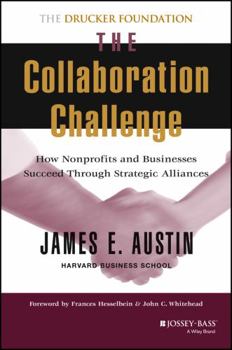The Collaboration Challenge: How Nonprofits and Businesses Succeed Through Strategic Alliances
Select Format
Select Condition 
Book Overview
James Austin, erfolgreicher Professor an der Harvard Business School, erläutert in diesem Band, wie Unternehmen ihr Grundgeschäft verbessern können, indem sie mit gemeinnützigen Organisationen zusammenarbeiten. Er beschreibt diese Zusammenarbeit als eine Art Symbiose, von der beide Seiten profitieren. Im 21. Jahrhundert ist der Konkurrenzkampf besonders hart, und sowohl Wirtschaftsunternehmen als auch gemeinnützige Organisationen kämpfen ums Überleben...
Format:Hardcover
Language:English
ISBN:0787952206
ISBN13:9780787952204
Release Date:April 2000
Publisher:Jossey-Bass
Length:224 Pages
Weight:0.90 lbs.
Dimensions:0.9" x 6.1" x 9.1"
Customer Reviews
3 ratings
Great Review in Foundation News & Commentary
Published by Thriftbooks.com User , 23 years ago
Foundation News and CommentaryJuly/August 2001Vol. 42, No. 4 Review by Beth BrownWe all want to partner. We all speak of collaborative spirit. But when the rubber meets the road, what does collaboration really entail, and what's the difference between a deal and an alliance? James Austin breaks down the notion of collaboration into a must-read users guide for any organizational leader embarking on a collaboration. And although the book is geared toward corporations and their nonprofit partners, many of the lessons are universal and can be applied to any individual or organization considering a joint venture, be it a marriage or cross-sector alliance.Austin notes the role serendipity and personal relationships plays in introducing partnerships-a conversation in a coffee shop or during a long plane ride-often sparking the "ah-ha" moment leading to the realization that a corporation and a nonprofit have what Austin calls mission mesh. The organizations' leaders can see how their visions' core competencies can make a whole greater than the sum of its parts. Through in-depth and candid examples from partnerships, including those between Starbucks and CARE, Timberland and City Year, and American Eagle Outfitters and Jumpstart, Austin chronicles the necessary, and often awkward, stages businesses and nonprofits pass through in order to become strategic partners.Austin has a healthy skepticism for the ease of collaboration. He often likens it to dating, and as with a courting pair from different countries, he sees the cultural and values barriers between the sectors as the greatest obstacle to collaboration. The corporate leaders he interviews are open about the fact that their bottom line is to make a profit and a partnership can often assist their public relations efforts. For the nonprofits, there is greater accountability held when working with corporations, and sometimes the social value nonprofits generate is not easily quantifiable. In addition, each can be associated with the mistakes of the other. However, the payoff is that one can also be associated with the success of the other and be exposed to new audiences-potential customers for the business, future partners for the nonprofit.One interesting observation Austin makes is the inherent noncollaborative nature of a philanthropic relationship (it is the lowest on the collaborative totem poll). Although he does not single out foundations, he characterizes the giving of money by one organization to another as an exchange of resources for warm fuzzy feelings. Among philanthropic relationships, the venture philanthropy approach seems to offer a model of partnership similar in the level of engagement to the examples mentioned in Austin's book.The details from the examples and extensive quotes of philanthropic and business leaders, such as Aaron Lieberman of Jumpstart and Jeff Swartz of Timberland, give the reader an insider's view of what went into the partnership. At the same time, the book is fil
Prize Winning Book
Published by Thriftbooks.com User , 23 years ago
At the Independent Sector's annual meeting in Atlanta on November 6, Professor James Austin of the Harvard Business School's Initiative on Social Enterprise was awarded one of The Virginia A. Hodgkinson Research Prizes for 2001for his book The Collaboration Challenge: How Nonprofits and Businesses Succeed Through Strategic Alliances. The two Prizes recognize outstanding published research that furthers understanding of philanthropy, voluntary action, nonprofits, and civil society in the United States and abroad. The Prize Selection Committee is comprised of five senior academic researchers and practitioners and is chaired by Professor Howard Tuckman, Dean of the Business School at Rutgers University. The prize is named in honor of Virginia Ann Hodgkinson, who is renowned worldwide as a driving force behind the development of research on the nonprofit sector and voluntary action.
Well written and practical.
Published by Thriftbooks.com User , 23 years ago
This is timely management book should be read by all those interested in leading, or advocating, a strategic alliance between a business and a non-profit, or by those who are already involved in such an alliance. The issues covered by the book are very topical. Strategic alliances have become increasingly important to organizational survival. In addition, some organizations, including businesses, recognize that, for the long haul, they need to be in closer harmony with deeper aspirations of their customers, employees and shareholders. Others oppose such approaches as a dangerous temptation to fuzzy thinking and conflicted agendas. Yet others view the non-economic motives of their constituents as only relevant to marketing campaigns or high-minded mission statements. This practical book addresses these opportunities and challenges systematically and with insight. It doesn't push quick fixes or high-risk strategies, but rather presents processes and analytical frameworks that support sequential acts of collaboration.The author is a good teacher and effectively uses case studies to support his recommendations. His approach is practical and recognizes the reality that every relationship involves an exchange of value. His emphasis is on having clear agendas and then searching together for common outcomes built around relative strengths.





